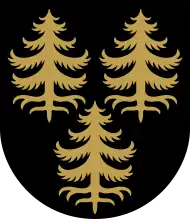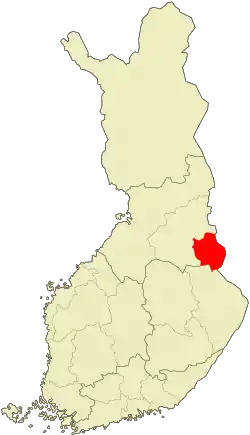Kuhmo
Kuhmo is a town and a municipality in Finland and is located at the south-eastern corner of the Kainuu region. The municipality has a population of 8,140 (31 July 2020)[2] and covers an area of 5,456.78 square kilometres (2,106.87 sq mi) of which 649.97 km2 (250.95 sq mi) is water.[1] The population density is 1.69 inhabitants per square kilometre (4.4/sq mi). It has a borderline of 120 kilometres (75 mi) with Russia (Finnish-Russian border). Neighbour towns are Hyrynsalmi, Lieksa, Nurmes, Ristijärvi, Sotkamo and Suomussalmi. A neighbour city across the Russian border is Kostomuksha. Vartius, one of the border crossing points between Finland and Russia, is located in northern Kuhmo.
Kuhmo | |
|---|---|
Town | |
| Kuhmon kaupunki Kuhmo stad | |
 The Town hall | |
 Coat of arms | |
 | |
| Coordinates: 64°07.5′N 029°31′E | |
| Country | |
| Region | Kainuu |
| Sub-region | Kehys-Kainuu sub-region |
| Charter | 1865 |
| City rights | 1986 |
| Government | |
| • Town Manager | Tytti Määttä |
| Area (2018-01-01)[1] | |
| • Total | 5,456.78 km2 (2,106.87 sq mi) |
| • Land | 4,806.85 km2 (1,855.94 sq mi) |
| • Water | 649.97 km2 (250.95 sq mi) |
| Area rank | 12th largest in Finland |
| Population (2020-07-31)[2] | |
| • Total | 8,140 |
| • Rank | 121st largest in Finland |
| • Density | 1.69/km2 (4.4/sq mi) |
| Population by native language | |
| • Finnish | 98.3% (official) |
| • Swedish | 0.1% |
| • Others | 1.6% |
| Population by age | |
| • 0 to 14 | 13.1% |
| • 15 to 64 | 63.5% |
| • 65 or older | 23.5% |
| Time zone | UTC+02:00 (EET) |
| • Summer (DST) | UTC+03:00 (EEST) |
| Municipal tax rate[5] | 20.25% |
| Website | www.kuhmo.fi |
Kuhmo´s eastern border is located at a drainage divider and town area belongs to drainage basin of Oulujärvi.
The municipality is unilingually Finnish.
History
The first inhabitants arrived in Kuhmo after the last ice-age, around 8000 BCE. Proof of Stone Age habitation has been found around Ontojärvi and Lammasjärvi. Sami people inhabited Kuhmo area until migration from Karelia and Savonia pushed Sami people up north. The influence of Sami culture is still found in the placenames. Wide spreading water routes are known to have attracted hunters, raiders, merchants and tax collectors since the 9th century.
In the Treaty of Nöteborg, the settlement between Sweden and the Novgorod Republic on August 12, 1323, the Kuhmo area belonged to Novgorod. Yet hunters and tax collectors kept on penetrating to the area from west. Swedish interest was to push the border further east.
Permanent habitation settled to the area after Gustav I, king of Sweden, had promised tax relief to peasants who would move north. Almost all the habitation was destroyed in the Russo-Swedish war between 1570 and 1595. In the Treaty of Teusina, the region of Kuhmo was annexed into Sweden. In the following centuries, this area was continuously raided in a number of wars and quarrels.
In 1809, Finland was annexed from Sweden to the Russian Empire as the Grand Duchy of Finland. For merchants from Karelia and Russia, Kuhmo became a trade route and a place to sell their goods. As a memorial of those merchants, on the market of Kuhmo there stands the statue “Laukunkantaja” (in English, "The Bag Bearer"). In this era, Elias Lönnrot, compiler of the Finnish National Epic Kalevala made his poem-collecting trips via Kuhmo to Karelia. Lönnrot made some of the editing in Kuhmo. Reconstruction of the hut where he has staying can be seen in the Kalevala village. Publishing Kalevala in 1835 fueled birth of Karelianism, which became a major trend in culture spheres towards the end of 19th century. Akseli Gallen-Kallela, who is considered as one of the founders of Karelianism, spent his honeymoon in Kuhmo. During their stay Gallen-Kallela painted some of his works at Lapinsalmi, lake Lentua. Scenery to lake Lentua based the background of the middle picture in his work Aino triptych.
During the 19th century burn-beating was still essential in agriculture but in decline. At the end of 18th century tar production had arrived to the area as a new and steadily growing source of income. In the year 1900 tar production in Kuhmo was highest in Finland, at 1.6 million litres. Tar was shipped from Kuhmo to Oulu by rowboats. Largest boats could carry 25 – 27 barrels, 125 litres each. Remains of tar pits, where tar was distilled from pine, can be found everywhere in the Kuhmo area.
The Winter War is an important event in the history of Kuhmo. During the war Kuhmo was bombarded 48 times and ground battles took place as near as ten kilometers from the center of the town. The Soviet army´s objective in Kuhmo was to proceed through Kuhmo and Kajaani to Oulu and divide Finland into two. The offensive was stopped on the Kuhmo – Saunajärvi road at Jyrkänkoski and on the Kuhmo – Kiekinkoski road at Tyrävaara, Both battlescenes are approximately 10 km from the city center. At narrow Kuhmo (Saunajärvi road) the Soviet 54th Division was forced to spread its troops which made Finnish guerilla tactics efficient. After being stopped, Soviet forces were divided and encircled into small pockets. A campaign to destroy the pockets and prevent the Soviet 44th Division from rescuing encircled forces continued until the Moscow peace treaty. After the war Kuhmo kept its eastern borderline unchanged, thus having an unchanged borderline for 400 years straight since the Treaty of Teusina of 1595.
Culture
Kuhmo is well known for its Kuhmo Chamber Music Festival which is held annually. The festival was founded in 1970 by cellist Seppo Kimanen and a small group of friends. A book on this subject was published in 2006.[6]
Geography and nature
By area the municipality is the second largest in the region (and the twelfth largest in the country), covering twice the land area of Luxembourg. The population is heavily concentrated in Kuhmo-town. Most of the area is very wild, featuring more than 600 lakes and for the rest extensively forested, providing a home to abundant wild life that includes bears, wolves and Finnish forest reindeer.
The Ministry of Agriculture and Forestry has set Kuhmo as a part of Eastern Finland´s stable bear population area. According to the plan, the population density of bears in this area will be maintained higher than in the rest of the country. The wolf population is also dense by comparison to the rest of the country. In consequence, the number of reindeer has decreased lately.
The topography is made up of low hills, of which the most significant are near the Russian frontier on the eastern side. To the south, Kuhmo is bordered by North Karelia.
Several nature reserves have been founded in Kuhmo for the protection of the frontier wilderness. Forest administration maintains several hiking routes on the reserves and almost all are accessible to the public.
Sights
- Kuhmo Arts Centre
- Kalevala Village
- Juminkeko – The Information Center for the Kalevala and Karelian Culture.[7]
- Petola Visitor Centre
International relations
Twin towns — Sister cities
Kuhmo is twinned with:
 Kostamus, Russia
Kostamus, Russia Oroszlány, Hungary
Oroszlány, Hungary Robertsfors, Sweden
Robertsfors, Sweden Šaľa, Slovakia
Šaľa, Slovakia
The Districts and Villages of the Town of Kuhmo
|
Districts:
|
Villages:
|
Villages: (cont'd)
|
Villages: (cont'd)
|
References
- "Area of Finnish Municipalities 1.1.2018" (PDF). National Land Survey of Finland. Retrieved 30 January 2018.
- "Suomen virallinen tilasto (SVT): Väestön ennakkotilasto [verkkojulkaisu]. Heinäkuu 2020" (in Finnish). Statistics Finland. Retrieved 13 September 2020.
- "Population according to language and the number of foreigners and land area km2 by area as of 31 December 2008". Statistics Finland's PX-Web databases. Statistics Finland. Retrieved 29 March 2009.
- "Population according to age and gender by area as of 31 December 2008". Statistics Finland's PX-Web databases. Statistics Finland. Retrieved 28 April 2009.
- "List of municipal and parish tax rates in 2011". Tax Administration of Finland. 29 November 2010. Retrieved 13 March 2011.
- Listen, there's music from the forest: a short presentation of the Kuhmo Chamber Music Festival", in English and French, by Jean-Jacques Subrenat, ISBN 978-952-92-0564-6.
- "Juminkeko – The Information Center for the Kalevala and Karelian Culture". Juminkeko.fi. Retrieved 2014-08-23.
External links
 Media related to Kuhmo at Wikimedia Commons
Media related to Kuhmo at Wikimedia Commons- Official website
- Kuhmo Chamber Music Festival
- Many links and much information about Kuhmo's services.

